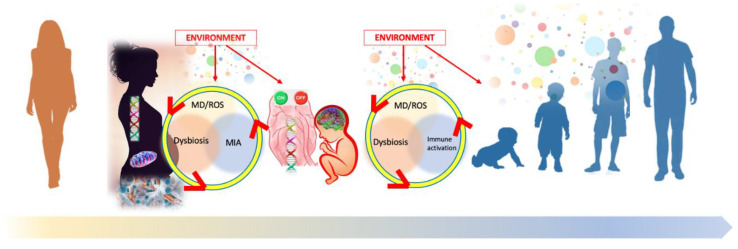Figure 1.
Interplay between the main determinants of Autism Spectrum Disorder. MD, Mitochondrial dysfunction; MIA, Maternal Immune Activation; ROS, Reactive Oxygen Species. In the new individual, matrilinear transfer of mitochondria and microbiota adds to the genetic information stored in the maternal and paternal germinal cells. Environmental factors as a whole may directly affect the epigenetic machinery, as it happens with heavy metals, or may influence the interconnected molecular pathways involved in the ‘bad trio’ (mitochondrial dysfunction (MT)/oxidative stress (ROS) plus maternal immune activation (MIA) plus dysbiosis). The ‘omniscient placenta’ [51] drives the metabolic and epigenetic regulation of fetal programming, hence influencing the ontogenesis and the crucial early stages of neurodevelopment. The epigenome—similarly to a software switching genes on and off [29]—is programmed in an adaptive and predictive sense by the intrauterine and cellular microenvironment, setting the limits of physiological adaptations to the postnatal environment and influencing the lifelong risk for diseases [43]. After birth, the same mechanisms involving environmental factors and the ‘bad trio’ are at play, and may continue to undermine human health lifelong. As for neurodevelopment, the maximum impact occurs in the first two years of life, which is the crucial time window for brain wiring.

